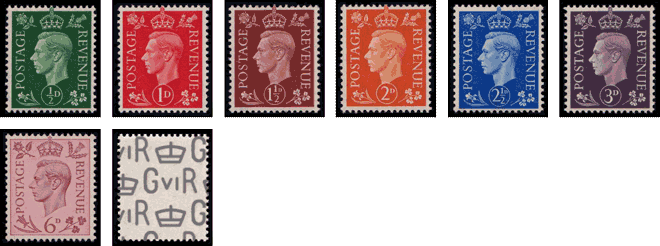
Stamps printed in dark colours were issued from May 1937, and rolls containing these stamps were issued either later the same year, or some early in 1938.
Following the limited set of 10 rolls issued during the reign of King Edward VIII, rolls of the new reign returned to the full set of 20 from the reign of King George V, with the addition of a 6d (J) roll in Jan 1939. The leaders were in the same colours as the stamps with text printed in black. Initially many leaders were in bright colours on white and overprinted “GVI” but these were later replaced with dull colours on buff without overprint.
The minimum Inland Letter Rate increased from 1½d to 2½d on 1 May 1940. The change so reduced demand for 1½d stamps that no further 1½d rolls were needed until 1950, and increased the demand for 2½d stamps so that continuous printing of 2½d rolls was adopted.
All stamps issued in rolls of this reign were printed in photogravure by Harrison.
First Issue
The first endways delivery rolls issued in 1937-38 were overprinted “GVI” to distinguish them from rolls of the previous reign, with a roll number to the left of the printed panel. Sideways delivery rolls were not so overprinted. Most leaders were brightly coloured with white backs. Roll (J) was not in the first issue.

| B | 1d | 960 | £4 | Lower End | Red/White | c * |
| C | 3d | 960 | £12 | Lower End | Sage-Green | 20 * |
| D | ½d | 960 | £2 | Lower End | Green/White | c * |
| E | 1d | 480 | £2 | Lower End | Red/White | c * |
| F | 2½d | 960 | £10 | Lower End | Pale Blue | 20 * |
| G | ½d | 480 | £1 | Lower End | Green/White | c * |
| K | 1½d | 960 | £6 | Lower End | Buff | c * |
| L | 1½d | 480 | £3 | Top End | Buff | c * |
| M | 2½d | 480 | £5 | Left Side | Pale Blue | 12 |
| N | 1½d | 480 | £3 | Left Side | Buff | csw |
| O | 1d | 480 | £2 | Left Side | Red/White | csw |
| P | ½d | 480 | £1 | Left Side | Green/White | csw |
| Q | 2d | 960 | £8 | Lower End | Orange/White | 20 * |
| R | 2d | 480 | £4 | Top End | Orange/White | 20 * |
| S | 3d | 480 | £6 | Left Side | Sage-Green | 12 |
| T | 2d | 480 | £4 | Left Side | Orange/White | csw |
| W | ½d | 960 | £2 | Lower End | Green/White | c * |
| X | 1d | 960 | £4 | Lower End | Red/White | c * |
| Y | ½d | 1,920 | £4 | Lower End | Green/White | c * |
| Z | 1d | 1,920 | £8 | Lower End | Red/White | c * |
c: continuous csw: continuous sideways 12/20: strips
* overprinted “GVI” to the right of the printed panel.
Langston & Corless list two (N) rolls with the dark colours 1½d, with a vague description of the position of the roll number. There are, however, three such rolls: no roll number, roll number to the right of the printed panel, and roll number both sides of the panel.
| B | 15.11.37 | C | 30.7.38 | D | 2.11.37 | E | 15.11.37 |
| F | 6.9.37 | G | 15.11.37 | K | 5.1.38 | L | 23.12.37 |
| M | 18.10.37 | N | 5.2.38 | O | 15.2.38 | P | 19.1.38 |
| Q | 14.2.38 | R | 2.5.38 | S | 8.6.38 | T | 2.2.38 |
| W | 28.10.37 | X | 8.10.37 | Y | 21.10.37 | Z | 5.10.37 |
Second Issue
The second issue of rolls did not have the “GVI” overprint, and the roll number was moved to the right of the printed panel. Leaders in bright colours on white were replaced with dull colours on buff. The first 6d (J) rolls were issued on 30 Jan 1939, and 2½d rolls (FM) were changed to continuous printing in 1940 (the minimum Inland Letter Rate increased from 1½d to 2½d in May 1940). There were no changes to (CQRS) rolls from the first issue.

| B | 1d | 960 | £4 | Lower End | Red/Buff | c |
| D | ½d | 960 | £2 | Lower End | Green/Buff | c |
| E | 1d | 480 | £2 | Lower End | Red/Buff | c |
| F | 2½d | 960 | £10 | Lower End | Blue/Buff | c |
| G | ½d | 480 | £1 | Lower End | Green/Buff | c |
| J | 6d | 480 | £12 | Lower End | Pink | 20 |
| K | 1½d | 960 | £6 | Lower End | Buff | c |
| L | 1½d | 480 | £3 | Top End | Buff | c |
| M | 2½d | 480 | £5 | Left Side | Blue/Buff | csw |
| N | 1½d | 480 | £3 | Left Side | Buff | csw * |
| O | 1d | 480 | £2 | Left Side | Red/Buff | csw |
| P | ½d | 480 | £1 | Left Side | Green/Buff | csw |
| Q | 2d | 960 | £8 | Lower End | Yellow/Buff | 20 † |
| T | 2d | 480 | £4 | Left Side | Yellow/Buff | csw |
| W | ½d | 960 | £2 | Lower End | Green/Buff | c |
| X | 1d | 960 | £4 | Lower End | Red/Buff | c |
| Y | ½d | 1,920 | £4 | Lower End | Green/Buff | c |
| Z | 1d | 1,920 | £8 | Lower End | Red/Buff | c |
c: continuous csw: continuous sideways 12/20: strips
* roll number to the right of the printed panel, then both sides of the panel.
† not listed by Langston & Corless.
Stamp Vending Machines
Rolls for use in Post Office vending machines (GEWXYZ) have 480, 960 or 1,920 stamps wound lengthways, facing inwards, onto ¾” diameter cores, for delivery lower end first.
First issue 1937-38 (roll numbers left):
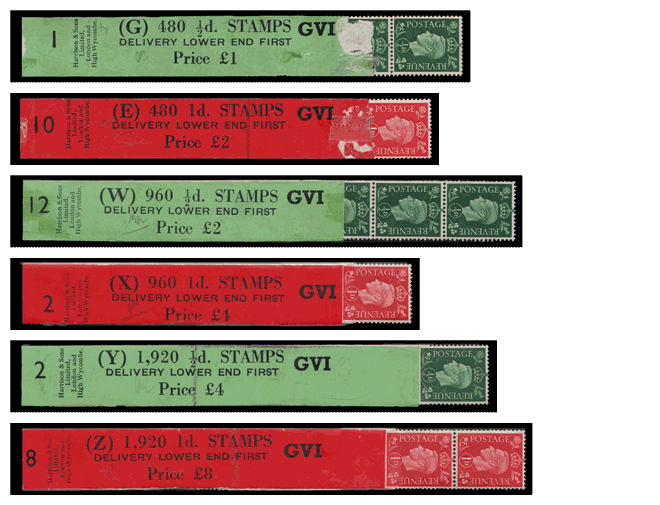
Second issue 1939-40 (roll numbers right):
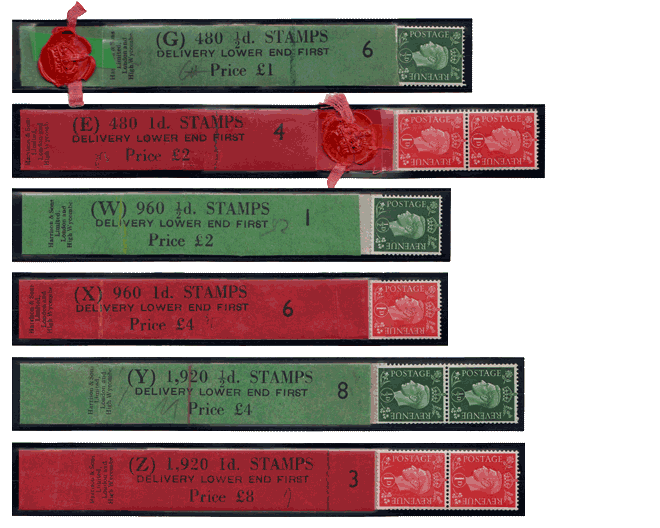
POKO Affixing Machines
Rolls for use in POKO affixing machines (DBKQFC) have 960 stamps, or (J) 480 stamps, wound lengthways, facing outwards, onto 1¼” diameter cores, for delivery lower end first.
First issue 1937-38 (roll numbers left):
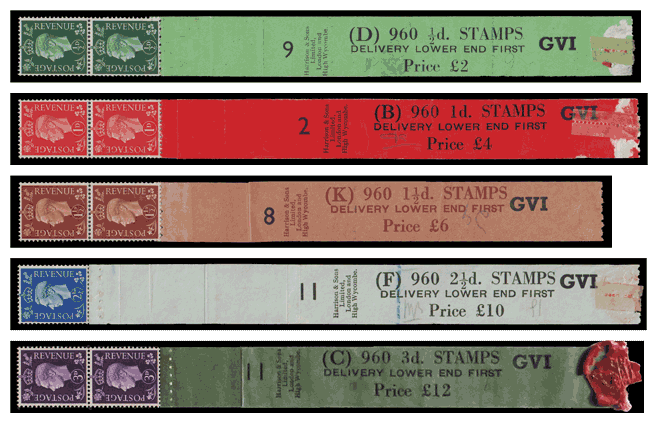
Second issue 1939-40 (roll numbers right):
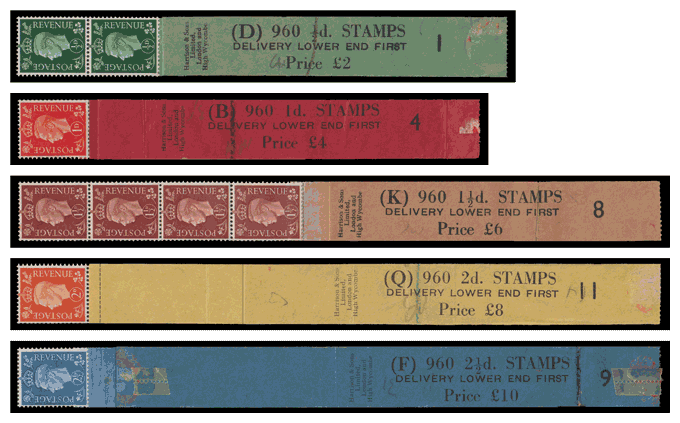

FIXO Affixing Machines
Rolls for use in FIXO affixing machines (LR) have 480 stamps wound lengthways, facing outwards, onto ½” diameter cores, for delivery top end first.
First issue 1937-38 (roll numbers left):

Multipost Affixing Machines
Rolls for use in Multipost affixing machines (PONTMS) have 480 stamps wound sideways, facing outwards, onto ½” diameter cores, for delivery left side first.
First issue 1937-38 (no roll numbers):
Continuously printed, watermark sideways (PONT):
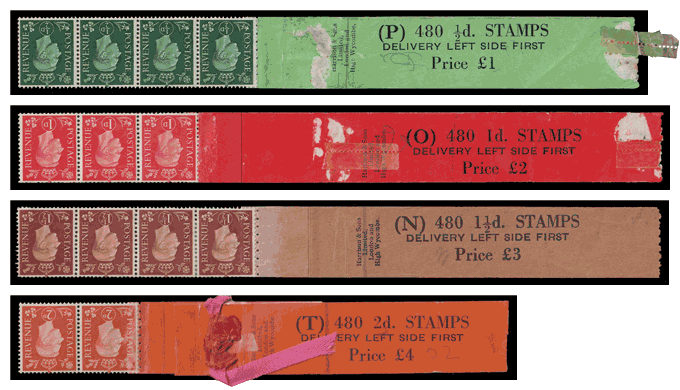
Made from strips of 12, watermark upright (MS):

Second issue 1939-40 (roll numbers right):
Continuously printed, watermark sideways (PONTM):
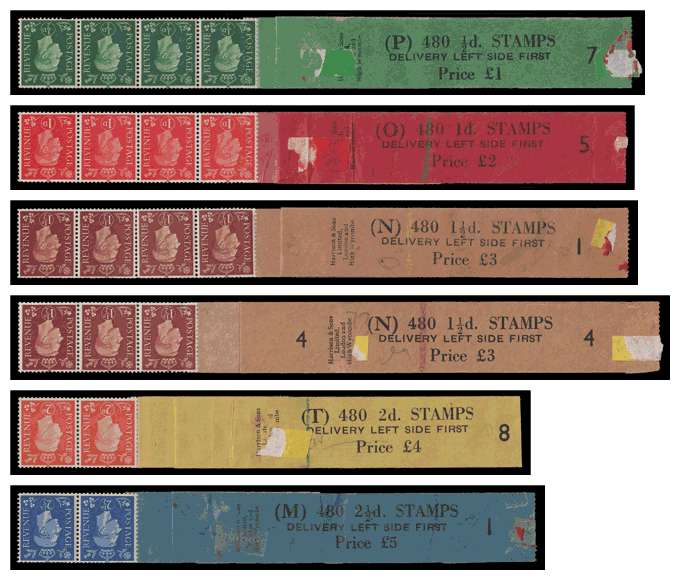
Next: KGVI Pale Colours